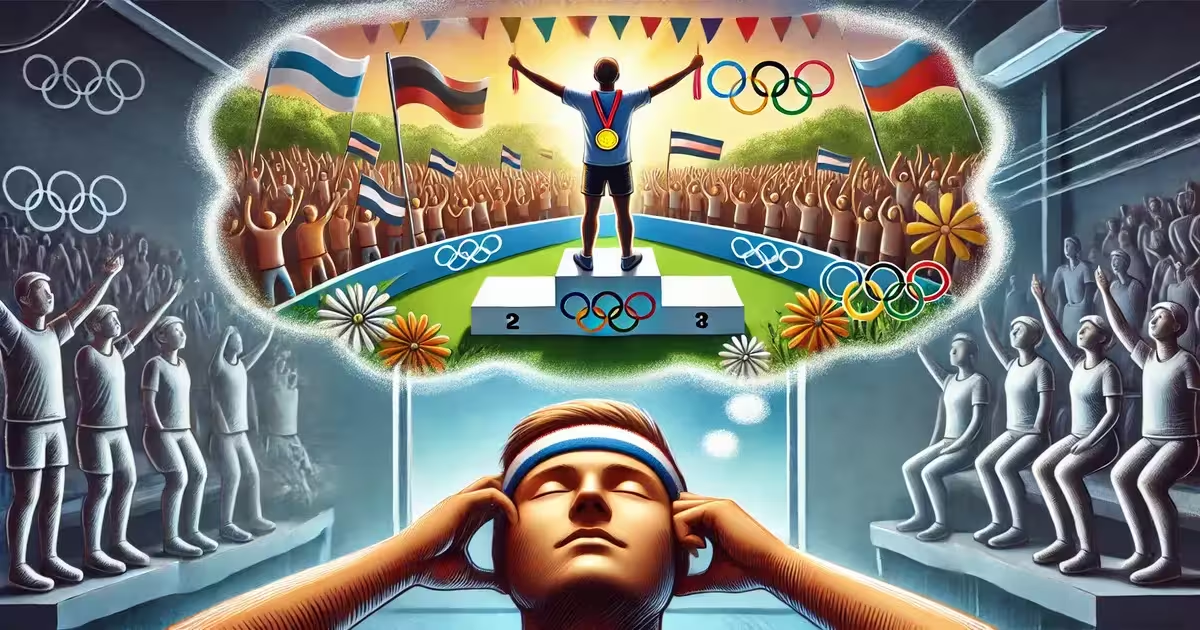How Visualization Techniques Help You Achieve Your Goals

Visualization techniques work because your brain activates the same neural pathways when imagining actions as during actual performance. This mental rehearsal builds confidence, reduces stress, and programs your subconscious to recognize opportunities.
Research shows visualization improves focus, increases motivation by up to 40%, and enhances performance across sports, academics, and professional settings.
Eight evidence-based techniques (creative visualization, vision boards, PETTLEP model, WOOP method, five senses practice, guided meditation, affirmations, and the 369 method) transform abstract goals into measurable results when practiced 6-19 minutes at least twice weekly.
The key is balancing outcome imagery with process visualization while avoiding passive fantasizing. Elite athletes and successful entrepreneurs use these methods because consistent mental practice creates neural pathways that prime your nervous system for peak performance before real-world execution.
What Visualization Really Means
The cognitive visualization technique is where you create detailed mental images of desired outcomes. You engage your imagination to see, hear, and feel success before it happens in reality.
This practice goes beyond daydreaming. Research from the University of Colorado Boulder confirms that imagination alters brain structure and function in measurable ways.
Brain scans reveal that mental imagery activates regions responsible for movement, emotion, and planning.
The process works through neural simulation. When you visualize yourself achieving a goal, your brain creates and strengthens the same neural connections used during actual performance.
Studies show this mental practice improves outcomes across diverse fields, from stroke recovery to creative writing.
Subscribe to Create Higher Vibrations!
Get Inspiration and Practical advice straight to your inbox.
Process vs. Outcome Matters
Research from UCLA reveals a critical distinction in how you visualize. Study participants who practiced process visualization (imagining the steps to study) scored eight points higher than those using outcome visualization (imagining receiving an A). The process group also started earlier and studied for more hours.
Process visualization prevents you from slipping into passive fantasizing. When you only imagine the result, you risk feeling satisfied without taking action. Visualizing the actual steps, challenges, and solutions keeps you grounded in reality while building motivation.
Neuroscience Behind Mental Imagery
Your brain cannot easily distinguish between vividly imagined actions and real ones. Functional MRI studies show that mental imagery activates visual cortex regions as early as V1, the primary visual processing area.
This neural overlap explains why visualization produces measurable physiological changes. Mental practice increases voluntary muscle contraction strength in both trained and untrained individuals.
Athletes who combine visualization with physical training outperform those who train physically alone. The effect size remains modest but statistically significant across populations and tasks.

Core Benefits Of Visualization Techniques
Visualization works through multiple proven mechanisms that strengthen both mental and physical performance. Research confirms this practice alters brain structure and function in measurable ways, creating neural pathways that support goal achievement.
Regular visualization trains your subconscious mind to recognize opportunities, take aligned action, and maintain focus on what matters most.

How to Practice Effectively
Start with the right environment. Find a quiet space where interruptions won’t break your concentration. Physical comfort matters because tension in your body interferes with mental focus.
Close your eyes gently. This eliminates visual distractions and directs attention inward. Some practitioners prefer a soft gaze at a fixed point, but most research supports eyes-closed practice for beginners.
Create detailed mental images using all five senses. See the environment where your goal unfolds. Hear the sounds around you. Feel the physical sensations in your body. Include taste and smell when relevant to make the experience immersive.
Stay anchored in the present moment during visualization. Your mind will wander, especially when starting. Notice when this happens and gently return focus to your mental imagery without judgment.
Timing and Frequency Guidelines
Research indicates optimal mental imagery sessions last between 6 and 19 minutes. Beginners may need longer durations as they build concentration skills. Experienced practitioners often achieve results in shorter, focused bursts.
Practice at least twice weekly to maintain neural benefits and skill consolidation. Daily practice produces stronger effects, particularly when combined with physical rehearsal. Meta-analysis shows the sweet spot for session length is approximately 21 minutes.
Implement structured programs over several weeks rather than sporadic practice. Your brain needs repeated exposure to form and strengthen neural pathways. Consistency matters more than intensity for long-term results.
Eight Proven Visualization Techniques
1.) Creative Visualization
Picture your desired outcome with vivid sensory details. Close your eyes and construct the scene where you achieve your goal. See yourself on the podium with a gold medal, feel its weight, and hear the crowd’s roar.
This foundational technique works by crystallizing your intentions. Regular practice keeps your goals front-of-mind and primes your subconscious to recognize relevant opportunities. Studies confirm that detailed mental images strengthen motivation and self-belief.
Incorporate both process and outcome elements. Visualize not just the result, but the steps you take to get there. This balanced approach prevents passive fantasizing while building realistic confidence.
2.) Vision Boards
Create visual representations of your goals using images, quotes, and symbols. Physical boards use magazine cutouts and printed photos arranged on a poster board. Digital versions work equally well through apps or Pinterest collections.
The technique keeps your aspirations visible throughout your day. Regular exposure reinforces your commitment and triggers motivation when you see the board. Place it where you’ll encounter it naturally, like your workspace or bedroom.
Vision boards complement but don’t replace active visualization practice. They serve as visual anchors that remind you to engage in deeper mental imagery work. Update your board as goals evolve or get achieved.
3.) Guided Meditation
Follow recorded sessions or attend groups that incorporate visualization into meditation practice. A narrator walks you through relaxation techniques followed by goal-focused mental imagery.
This approach reduces performance anxiety and stress while building visualization skills. The structured format helps beginners who struggle with self-directed practice. Regular meditation will improve concentration, which enhances all visualization work.
Guided sessions typically last 10 to 20 minutes, fitting the research-backed optimal duration. Apps and YouTube channels offer free options targeting specific goals from athletic performance to career success.
Discover Your Inner Self. Join Our Self-Mastery Program.
Self-Mastery Coaching gives you the space, tools, and guidance to grow, reflect and discover your values and inner strength.

4.) The PETTLEP Model
Use this advanced framework developed by sports psychologists Holmes and Collins. PETTLEP stands for Physical, Environment, Task, Timing, Learning, Emotion, and Perspective.
Make your visualization physically realistic by imagining your body position, equipment, and attire. Include environmental details like location and clothing that match actual performance conditions. Visualize the specific task exactly as you’ll execute it.
Practice in real-time speed, though slow-motion imagery helps with complex new skills. Adjust your mental images as your actual abilities improve, keeping the visualization aligned with your current skill level.
Include authentic emotional states, both positive feelings and challenging scenarios you might face.
Choose first-person perspective (seeing through your own eyes) or third-person (watching yourself) based on the task. First-person typically works better for motor skills, while third-person helps with form correction.
5.) Five Senses Visualization
Extend creative visualization by deliberately engaging all sensory channels. Mental imagery becomes more powerful when it includes visual, auditory, kinesthetic, olfactory, and gustatory elements.
Close your eyes and build the scene systematically. What do you see in detail? What sounds surround you? What physical sensations do you feel in your body? Are there relevant smells or tastes?
This multisensory approach creates stronger neural activation patterns. The richer your mental simulation, the more closely it mimics experience in your brain. Research shows this technique helps your subconscious accept visualized outcomes as achievable reality.
6.) Mental Contrasting and WOOP
Combine positive visualization with realistic obstacle planning using the WOOP method. Developed by psychologist Gabriele Oettingen, this technique outperforms pure positive thinking.
Start with your Wish, a challenging yet feasible goal. Visualize the best Outcome and how achieving it would feel. Identify internal Obstacles that might block your progress. Create specific Plans using if-then statements for each obstacle.
This mental contrasting prevents the motivation trap of positive fantasizing. Studies show that imagining only positive outcomes can reduce actual effort because your brain mistakes the fantasy for accomplishment. WOOP balances optimism with pragmatic preparation.
Implementation intentions formed through if-then planning dramatically increase follow-through. When you decide in advance how you’ll respond to specific obstacles, you bypass the need for willpower in the moment.
7.) Affirmations with Visualization
Pair positive self-statements with mental imagery for reinforced impact. Affirmations are short declarations like “I am confident and capable” that you repeat during visualization sessions.
State affirmations in the present tense as if already true. This linguistic framing activates neural pathways associated with the desired state. Combine the verbal statement with a vivid mental image of yourself embodying that quality.
Repeat affirmations multiple times daily, especially during morning and evening visualization practice. Consistency builds the neural patterns over time. This technique maintains a positive mindset and counteracts self-doubt.
8.) The 369 Method
Write your goals and affirmations three times each morning, six times midday, and nine times before bed. Proponents claim this pattern harnesses universal energy principles.
While scientific evidence specifically for the 369 pattern remains limited, the underlying principle of spaced repetition has strong research support. Writing goals by hand engages motor learning and reinforces memory. Multiple daily repetitions keep your objectives in conscious awareness.
This structured approach works best when combined with visualization during the writing process. As you write each repetition, pause to create a brief mental image of the goal achieved.
Common Mistakes to Avoid
Most people sabotage their visualization practice before it even starts working. Research shows these errors prevent your brain from forming the neural connections needed for success.
Recognizing and correcting these mistakes transforms ineffective daydreaming into powerful mental training that produces measurable results.

Implementation Strategy
Begin with one technique rather than attempting all eight simultaneously. Master the fundamentals of creative visualization before adding complexity. Two weeks of consistent daily practice build the foundation.
Start with five-minute sessions and gradually extend to the 6-19 minute research-backed optimal range. Shorter, focused sessions outperform longer, distracted ones. Set a specific time each day to build the habit.
Track your practice and progress in a journal. Take note of which techniques resonate and produce results. Adjust your approach based on what works for your brain and goals.
Combine mental imagery with physical action steps. Use visualization to prepare before important events and to process experiences afterward. This integration maximizes the synergistic benefits.
Taking Your First Steps
Visualization techniques offer a scientifically validated path to goal achievement. The practice works by activating neural pathways, reducing anxiety, improving focus, and programming your subconscious for success.
Start today with a simple five-minute creative visualization session. Choose one specific goal and imagine yourself achieving it with full sensory detail. Practice twice weekly at a minimum, working toward daily sessions.
Remember that mental practice complements physical effort. Visualization creates the neural foundation, but real-world action builds the results. Balance optimistic imagery with realistic planning using techniques like WOOP.
Your brain cannot distinguish vividly imagined experiences from real ones. Use this neurological reality to prepare for success before it arrives. The research confirms that consistent visualization practice produces measurable improvements across virtually every field of human performance.
Final Thoughts
Self-Awareness and Time Management: Mastering Your ProductivityVisualization techniques offer a remarkable path to achieving your goals and living your dream life. By learning and practicing these methods, you’re not only tapping into your subconscious mind but also connecting with the universe’s energy to manifest your desires.
As you begin on this transformative journey, remember that consistency, dedication, and a positive mindset are essential for success.
Embrace the power of visualization, and watch as your goals become a reality, one vibrant mental image at a time. So, go ahead and harness the power of visualization techniques today – your future self will thank you for it!


